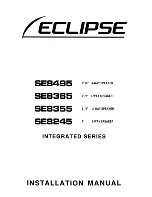
- SS-HQ1 Application Notes -
Ver.1.0.0 January 7, 2005
160
Blemish detection results
The blemish detection results (type, level, address) are written to these parameters. Blemish detection results
for a total of 32 blemishes may be written. (If there are fewer than 32 blemishes [e.g., if there are just two
blemishes], the other parameters are left at their initial values and are not overwritten.)
Blemish detection results are written in order of blemish level, starting with the highest blemish level. If
blemishes are detected through both static detection and dynamic detection, the blemishes found through
static detection are written first.
Table 11.2-6 Parameters for storing blemish detection results
Parameter
Description
SD
n*
Blemish detection type
0[h]: Static detection
1[h]: Dynamic detection
LARGE
n*
Blemish type
0[h]: Normal blemish
1[h]: Large blemish
VCNT
n*
Vertical address of blemish
HCNT
n*
Horizontal address of blemish
DETLV
n*
CAT11_Byte20-147
Blemish level
10bit data
* n:0 - 31
* These parameters can be used for both static detection and dynamic detection.
Blemish address resetting
This parameter is used to reset the values of parameters storing blemish detection results (all values are set to
“00[h]”).
Note that if blemish detection results are written to EEPROM (blemishes detected through static detection), the
EEPROM values are not reset. This parameter resets the blemish detection results that have been applied to
registers. (To reset EEPROM data, write “00[h]” to EEPROM.)
If this parameter is set to “1[h]” (reset ON), the blemish detection operation will not be performed, so normally it
should be set to “0[h]”.
Table 11.2-7 Parameter for resetting blemish address
Parameter
Description
ADDRRST CAT11_Byte18_bit0
0[h]: Normal blemish detection operation
1[h]: Resets blemish detection results
* These parameters can be used for both static detection and dynamic detection.
* Enabled when DYNDETON=0[h] and DYNDELON=0[h]
















































